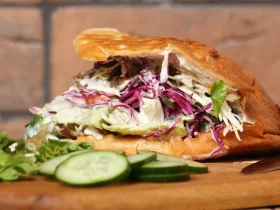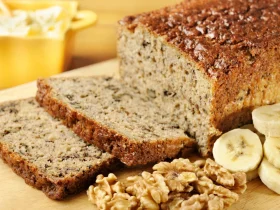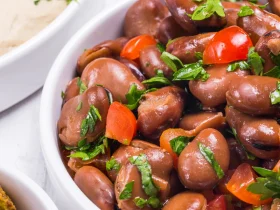When the chilly winds of winter blow, there’s nothing quite like a warm bowl of red bean soup with rice balls to soothe the soul and warm the heart. This delectable East Asian treat combines the sweetness of red beans with the chewy texture of rice balls, creating a harmony of flavors and sensations that’s nothing short of delightful. Whether you’re a culinary novice or a seasoned chef, this recipe is bound to become a favorite in your kitchen. So, roll up your sleeves and let’s dive into the world of red bean soup with rice balls!
[ez-toc]
History
Delving into the past, we uncover the fascinating journey that led to the creation of red bean soup with rice balls. This beloved dessert boasts a rich history that stretches back through the annals of East Asian cuisine, intertwining cultural traditions and culinary creativity.
Ancient Beginnings
The origins of red bean soup can be traced back to ancient China, where red beans were revered not only for their vibrant color but also for their medicinal properties. In Chinese traditional medicine, red beans were believed to have a cooling effect on the body, making them a popular choice for concocting refreshing summer beverages and soothing desserts. The beans were often used to prepare sweet soups to counteract the heat of the summer months.
Cultural Significance
As the centuries rolled on, red bean soup transitioned from being merely a refreshing beverage to a symbol of family togetherness and celebration. It became a staple at festive occasions, including weddings, Lunar New Year gatherings, and other important events. The dish’s deep red hue came to symbolize happiness, good fortune, and auspicious beginnings in Chinese culture.
Evolution and Adaptation
As time progressed, red bean soup traveled across borders and gained popularity in other East Asian countries, including Japan, Korea, and Taiwan. Each region added its own unique twists to the recipe, incorporating local ingredients and culinary techniques. In Japan, for instance, the dessert took on the name “zenzai” and often includes mochi, a chewy rice cake, instead of rice balls. In Korea, “patjuk” features red bean porridge enjoyed during festive occasions.
Modern Innovations
In recent years, the popularity of red bean soup with rice balls has extended beyond East Asia and captured the hearts of food enthusiasts around the globe. As globalization has brought diverse flavors together, creative chefs and home cooks have experimented with variations of the classic recipe. From adding modern toppings like ice cream to infusing the soup with contemporary flavors, the dessert continues to evolve while honoring its cultural roots.
A Heartwarming Tradition
Today, red bean soup with rice balls stands as a heartwarming tradition that bridges generations and cultures. It’s a dish that transcends geographical boundaries, bringing comfort and joy to those who savor it. Whether enjoyed as a nostalgic treat or discovered as a new culinary delight, this dessert remains a testament to the power of food to connect us to our heritage and to each other.
So, as you prepare your own bowl of red bean soup with rice balls, take a moment to appreciate the journey that has brought this cherished recipe to your kitchen—a journey filled with centuries of history, culture, and the shared delight of a simple yet profoundly comforting dessert.
Time
| Step | Time |
|---|---|
| Soaking the Red Beans | Overnight |
| Simmering the Red Beans | 1 to 1.5 hours |
| Mixing the Glutinous Rice Flour | 10 minutes |
| Shaping the Rice Balls | 20 minutes |
| Cooking Rice Balls in Soup | 10-15 minutes |
Please note that these times are approximate and may vary based on individual cooking equipment and techniques.
Ingredients
| Red Bean Soup Ingredients | Rice Ball Ingredients |
|---|---|
| Dried red beans (1/2 cup) | Glutinous rice flour (1/2 cup) |
| Water (4 cups) | Water (1/4 cup) |
| Rock sugar (to taste) | Food coloring (optional) |
| Pandan leaves (optional) |
This table outlines the ingredients required to create a delightful serving of red bean soup with rice balls for two people. Adjust quantities accordingly for more servings.
Directions
Step 1: Soaking the Red Beans
Time: Overnight
- Place the dried red beans in a bowl.
- Cover the red beans with water and let them soak overnight. This softens the beans and reduces their cooking time.
- Once the red beans are plump and rehydrated, drain them.
Step 2: Simmering the Red Beans
Time: 1 to 1.5 hours
- In a pot, combine the soaked red beans and fresh water (4 cups).
- Bring the mixture to a boil over medium heat.
- Reduce the heat to a gentle simmer and add pandan leaves for fragrance (if desired).
- Allow the red beans to cook for 1 to 1.5 hours, or until they are tender and easily mashed.
- Once the beans are soft, add rock sugar to taste and let it dissolve into the soup, infusing it with sweetness.
Step 3: Mixing the Glutinous Rice Flour
Time: 10 minutes
- In a mixing bowl, combine the glutinous rice flour (1/2 cup) and water (1/4 cup).
- Knead the mixture until it forms a smooth and pliable dough. The dough should be easy to work with and not too sticky.
- If you’d like, add a few drops of food coloring to the dough and knead until the color is evenly distributed.
Step 4: Shaping the Rice Balls
Time: 20 minutes
- Take small portions of the rice dough and roll them between your palms to form bite-sized balls.
- Keep in mind that the rice balls will expand slightly during cooking, so don’t make them too large.
- Place the shaped rice balls on a clean surface and cover them to prevent drying.
Step 5: Cooking Rice Balls in Soup
Time: 10-15 minutes
- Gently place the rice balls into the simmering red bean soup.
- Let the rice balls cook for about 10-15 minutes, or until they float to the surface. Floating indicates that they are cooked through.
- Once the rice balls are cooked, remove the pot from heat.
Step 6: Serving and Enjoying
- Ladle the red bean soup and rice balls into serving bowls.
- The contrasting textures of the silky red bean soup and chewy rice balls create a delightful combination.
- Serve the dessert hot to fully savor the melded flavors and comforting warmth.
Step 7: Customizing Your Creation
- While the classic red bean soup with rice balls is exquisite on its own, you can get creative with toppings.
- Consider adding a scoop of coconut ice cream or a sprinkle of toasted sesame seeds for extra flavor and texture.
Step 8: Health Benefits to Savor
- Beyond its delectable taste, the red bean soup with rice balls offers health benefits.
- The red beans are rich in fiber and essential nutrients, promoting digestive health.
- The glutinous rice provides a source of energy, making this dessert both delicious and nourishing.
Step 9: A Dash of History: The Origins of Red Bean Soup
- Delve into the cultural history of red bean soup, tracing its roots back to ancient China and its evolution across East Asian countries.
- Discover how this dessert has become a symbol of togetherness and celebration.
Step 10: Troubleshooting Tips: Common Mistakes to Avoid
10.1 Soup Too Thin? Thickening Solutions
- If the red bean soup turns out thinner than desired, create a mixture of cornstarch and water.
- Gradually stir the cornstarch mixture into the soup and let it simmer for a few minutes until it thickens to your preference.
10.2 Rice Balls Cracking? Problem-Solving
- If your rice balls are cracking during cooking, this could be due to insufficient water in the dough or overworking it.
- Lightly moisten your hands when shaping the balls and handle the dough gently to prevent cracks.
Follow these steps to create a heartwarming bowl of red bean soup with rice balls, and embark on a culinary adventure that melds tradition, flavor, and comfort.
Equipment Required
Nutrition Information
| Nutrition Information (Per Serving) | Amount |
|---|---|
| Serving Size | 1 bowl |
| Calories | 280 kcal |
| Total Fat | 1.5 g |
| Saturated Fat | 0.3 g |
| Trans Fat | 0 g |
| Cholesterol | 0 mg |
| Sodium | 10 mg |
| Total Carbohydrates | 63 g |
| Dietary Fiber | 7 g |
| Sugars | 21 g |
| Protein | 5 g |
| Vitamin D | 0 mcg |
| Calcium | 30 mg |
| Iron | 1.5 mg |
| Potassium | 240 mg |
Please note that these values are approximate and can vary based on the specific ingredients and portion sizes used. Adjustments to the recipe or variations may alter the nutritional content.
Tips
- Quality of Red Beans: Opt for high-quality dried red beans for the best results. Freshness matters, as older beans might take longer to cook and may not yield the desired tenderness.
- Pandan Leaves: While pandan leaves add a lovely fragrance, they’re optional. If unavailable, you can skip them without significantly affecting the flavor.
- Testing Rice Ball Doneness: To check if the rice balls are cooked, simply take one out and cut it open. The center should be fully cooked and no longer doughy.
- Consistency of Dough: When shaping the rice balls, ensure that the dough isn’t too dry or too sticky. Adjust the water or rice flour as needed to achieve the right texture.
Pros & Cons
| Pros | Cons |
|---|---|
| ✅ Comforting and heartwarming dessert | ❌ Requires advance soaking of red beans |
| ✅ Rich in fiber and essential nutrients | ❌ Cooking time for red beans is lengthy |
| ✅ Offers customization with various toppings | ❌ Glutinous rice flour can be sticky to work with |
| ✅ Cultural significance and history | ❌ May not be suitable for low-carb diets |
| ✅ Can be made vegan-friendly | ❌ Could be too sweet for some preferences |
Conclusion
As we conclude our journey into the world of red bean soup with rice balls, we find ourselves immersed in a culinary experience that marries flavors, history, and heartwarming comfort. This delightful dessert, steeped in cultural significance and ancient traditions, offers not only a tantalizing taste but also a window into the past—a past where families gathered and celebrations were cherished.
With each spoonful of velvety red bean soup and each chewy rice ball, you’re invited to savor not just the melding of textures and flavors, but also the legacy of generations that have passed down this cherished recipe. Whether enjoyed in the midst of a chilly evening, as a gesture of hospitality, or simply as a treat for yourself, this dish encapsulates the essence of shared joy and connection.
So, why not roll up your sleeves and embark on your own culinary adventure? Let the aroma of simmering red beans and the playful dance of rice balls inspire you to create a masterpiece that warms the heart and nurtures the soul. Whether you’re an experienced chef or a kitchen novice, this recipe welcomes all with open arms.
Remember, every creation is an expression of yourself. So, add your personal touch, customize, and savor the satisfaction of crafting a dish that brings comfort, culture, and delight to your table. It’s more than just a recipe; it’s an invitation to embrace tradition and embark on a journey that nourishes both body and spirit. So, gather your ingredients, follow the steps, and let the aroma of red bean soup and rice balls fill your kitchen with warmth and memories.
Get ready to taste the sweetness of history and tradition—bite by delicious bite. Your journey begins here, with a bowlful of red bean soup and rice balls waiting to be savored and shared. Happy cooking! 🍲🌟
Facts
- 🌱 Fact 1: Ancient Origins and the Sweet Symbolism 🍡
- Did you know that red bean soup dates back to ancient China, where it was treasured not only for its taste but also for its supposed cooling effects? In Chinese traditional medicine, red beans were believed to help beat the heat. The red hue of the beans symbolized happiness and auspicious beginnings, making this dessert a sweet treat with deeper meaning.
- 🌍 Fact 2: A Cross-Cultural Delight 🌈
- Red bean soup with rice balls has traveled far beyond its Chinese origins. It’s like a culinary passport, embraced by various East Asian countries. Japan adds its twist with “zenzai,” often featuring chewy mochi. In Korea, “patjuk” combines red bean porridge with rich traditions. It’s a cross-cultural dessert that bridges nations through taste and tradition.
- 🎨 Fact 3: Red Bean Rainbow 🌺
- While the classic recipe brings comfort, don’t be afraid to unleash your inner artist. Play around with food coloring to create a vibrant rainbow of rice balls. Imagine enjoying a bowlful of colorful joy, each bite a surprise of flavor and hue. It’s not just dessert; it’s edible art!
- 🚀 Fact 4: Ancient Recipe, Modern Twists 🌟
- Just like a classic novel that gets modern adaptations, this dessert has undergone a transformation. Creative chefs have elevated it to new heights—imagine red bean soup ice cream or rice ball sundaes! While honoring tradition, this dish isn’t afraid to don a contemporary cloak and dazzle taste buds anew.
- 🍬 Fact 5: A Sweet Burst of Nostalgia 🕰️
- Red bean soup with rice balls isn’t just food; it’s a portal to the past. Each bite carries the memories of generations before us. Whether shared around a family table or relished alone, it’s a taste that evokes warmth, stories, and a sweet nostalgia that transcends time.
FAQ’s
Can I use canned red beans for the soup?
Absolutely! While using dried red beans is traditional, canned red beans can be a convenient alternative. Rinse them thoroughly before adding to the pot.
Can I freeze the rice balls for later?
Yes, you can! After shaping the rice balls, place them on a baking sheet lined with parchment paper and freeze until firm. Transfer them to an airtight container or freezer bag for longer storage.
Is this dessert suitable for vegans?
Yes, it can be! Opt for plant-based rock sugar or sweeteners and ensure your glutinous rice flour is free from animal-derived additives.
How can I make the soup less sweet?
To reduce the sweetness, you can either reduce the amount of rock sugar added or opt for a less sweet variety of rock sugar. Taste and adjust according to your preference.
What other toppings can I add to the soup?
The possibilities are endless! Consider adding a scoop of coconut ice cream, crushed peanuts, diced fruit, toasted coconut flakes, or a drizzle of honey for additional flavor and texture.
Can I use regular rice flour instead of glutinous rice flour?
It’s best to stick with glutinous rice flour, as it provides the chewy texture required for the rice balls. Regular rice flour won’t yield the same results.
Can I use a rice cooker to make this recipe?
While the traditional stovetop method is recommended, some rice cookers with a “steam” or “dessert” function can be used to cook the rice balls in the soup. Follow your rice cooker’s instructions for best results.
Can I add more ingredients to the soup, like tapioca pearls or lotus seeds?
Absolutely! Feel free to experiment with additional ingredients like tapioca pearls, lotus seeds, or other sweet ingredients. Just ensure they are pre-cooked or soaked as needed.
Can I use brown sugar instead of rock sugar?
Yes, you can substitute brown sugar for rock sugar. Keep in mind that brown sugar has a distinct flavor, which might alter the taste of the soup slightly.
How do I prevent the rice balls from sticking together?
After shaping the rice balls, place them on a clean surface and cover them to prevent sticking. Avoid stacking or overcrowding the rice balls during this stage to prevent them from sticking together.













Leave a Reply